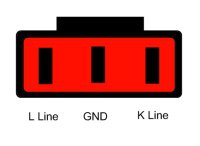Ok folks, I have good news.
After some initial problems communicating with the ECU in the car (mainly with the software), I think I have cracked it.
I have got the ISO code out on Key ON, sent the init sequence and talked to the ECU through a PIC at 7812.5 baud.
I read the battery voltage, throttle position, non-validated errors, validated errors, entered active diagnostics mode, run the fuel pump as part of AD mode, and cleared the error memory.
I've tried a few cycles of this and it all works consistently.

At the minute I am running it through a pretty basic interface, that outputs hexadecimal data and allows me to request data from the ecu by typing in the hex code for the data I want. So it's not exactly very elegant, but it works for testing.
I now want to knock up a GUI interface for the laptop that will be a bit more streamlined.
A basic overview of what I've done is attached below.
Is anyone still interested in developing the ECU reader, I would like to get some input on features, etc?



